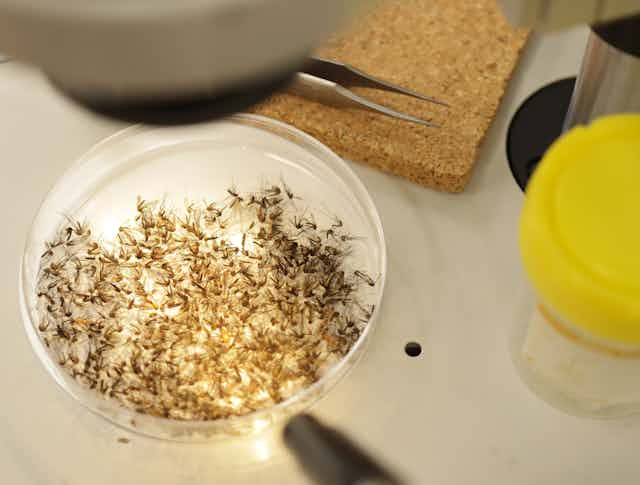Where there’s water, you’ll find mosquitoes – including some that transmit viruses that can make us seriously ill.
Authorities have been on alert after an outbreak of Japanese encephalitis last summer which resulted in 45 human cases and seven deaths. Favourable conditions for mosquitoes continued.
Now, we’ve seen the return of another pathogen to southeastern Australia: Murray Valley encephalitis virus. Mosquitoes carrying the virus have been detected in New South Wales and northern Victoria.
While Murray Valley encephalitis is endemic in Northern Australia, meaning it is always present in mosquitoes, it’s not often detected in southeastern Australia. No human cases have yet been reported in the southern states, but past outbreaks after floods show we need to be cautious.
Read more: How to mozzie-proof your property after a flood and cut your risk of mosquito-borne disease
What is Murray Valley encephalitis virus?
Murray Valley encephalitis virus is a member of the Flavivirus family, which includes Japanese encephalitis, dengue, yellow fever and West Nile viruses.
Murray Valley encephalitis causes similar symptoms to Japanese encephalitis virus. Encephalitis means inflammation, or swelling, of the brain.
Only a small proportion of people infected, perhaps as few as one in 1,000, will develop symptoms. These include fever, headache and vomiting, as well as neurological problems resulting in confusion, dizziness, or loss of consciousness.
The disease, like that caused by Japanese encephalitis virus, is fatal in up to 30% of those who get symptoms.
People who survive may have permanent neurological complications that require life-long medical care. Only around 40% of those experiencing severe symptoms recover completely.
How does it spread?
Waterbirds such as herons and egrets are the natural hosts of the virus. Mosquitoes pick up the virus as they feed on the blood of birds, and then pass it on to people when the mosquitoes bite again.
The key mosquito driving spread of the virus is Culex annulirostris. It thrives in freshwater habitats and travels many kilometres from local wetlands.

The virus circulates between mosquitoes and waterbirds during the wet season in northern Australia, particularly in the Kimberley region.
After flooding, the virus makes its way into southeastern Australia from northern regions of the country. Waterbirds travel to newly flooded areas for favourable feeding and breeding conditions.
With flooding continuing in southeastern Australia, as well as Queensland and Western Australia, mosquito numbers are expected to remain high in many regions of Australia for months ahead. More mosquitoes and more waterbirds increase the likelihood of infection in people.

What happened in past outbreaks?
The virus was first isolated in 1951 from patients who died from encephalitis in the Murray Valley. The outbreak included 45 reported cases, including 19 deaths.
But that wasn’t the first or last outbreak. There is evidence the virus was causing human disease in the early 1900s and at the time was known as “Australian X disease”.
The most significant outbreak occurred in 1974 with 58 cases reported including 13 fatalities. Seasonal agricultural workers became reluctant to travel to the regions impacted by the virus.
The virus didn’t disappear after 1974. It has been sporadically detected in humans, mosquitoes, or other animals, most commonly in northern and central Australia.
The largest outbreak since 1974 in southeastern Australia was in 2011, with a total of 17 cases reported including three deaths.
The major trigger for previous outbreaks has always been above average rainfall.
What can we do about it?
Unlike Japanese encephalitis, there is no vaccine for Murray Valley encephalitis.
Preventing mosquito bites is critical to stop infection. The steps you take to stop mosquito bites every other summer will reduce the spread of Murray Valley encephalitis virus too.
Read more: Mozzies biting? Here's how to choose a repellent (and how to use it for the best protection)
Those spending lots of time outdoors face the greatest risk. To reduce mosquito bites:
avoid outdoor activity at dusk and during evening near wetlands or bushland areas where mosquitoes are active
cover up with light coloured, loose-fitting, long-sleeved shirts with long pants and covered shoes
use topical insect repellents containing diethytoluamide, picaridin, or oil of lemon eucalyptus. These formulations will provide the longest-lasting protection against mosquito bites if applied to all exposed areas of skin
use insect screens and nets around the home on windows and doors, and while camping
use “knockdown” insect sprays and plug-in repellent devices indoors or in sheltered outdoor areas.
The risk of Murray Valley encephalitis virus will remain for months ahead. It’s not until the colder weather of autumn arrives that mosquito populations will decline and with them the risks of disease.
Perhaps the return of El Niño dominated weather patterns in coming years, with less rainfall and fewer favourable breeding spots for mosquitoes and waterbirds, the virus will disappear from southeastern Australia. But for how long?
Read more: Feel like you're a mozzie magnet? It's true – mosquitoes prefer to bite some people over others

